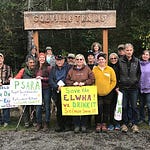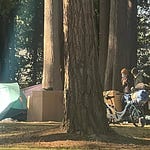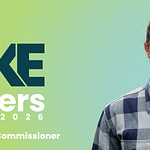Who’s really in charge of the Dungeness Off-Channel Reservoir? County officials say Public Works is leading the project—but the County Charter, floodplain laws, and environmental regulations point to the Department of Community Development. As political donations, legal ambiguity, and quiet re-planning swirl around one of the most expensive water projects in County history, the real danger may be that no one’s truly accountable. And if the Charter has been violated? The entire project could grind to a halt—just like Towne Road.
When it comes to the Dungeness Off-Channel Reservoir, Clallam County officials have a favorite phrase: “This is a Public Works project.” That’s the explanation offered every time questions are raised about oversight, planning authority, or the slow-motion reconfiguration of the project to sidestep regulatory roadblocks and public scrutiny.
In a recent letter, Clallam County Department of Community Development (DCD) Director Bruce Emery responded to concerns that the reservoir should be overseen by his department, not the Board of Commissioners. You can read his full statement in the attachment below. But one central claim stands out:
“To assign this portion of the project to the DCD, or any other County Department, would be a misassignment of the task and result in significant inefficiency…”
That may sound reasonable—until you look at the County Charter, and at the history and scope of the DCD itself.
A narrow reading of a broad mandate
Emery’s defense rests on the idea that “planning” and “infrastructure” are separate spheres. But that interpretation doesn’t line up with either the language of the Clallam County Charter or the realities of this project.
According to Section 4.25 of the Charter, the DCD shall:
“administer all laws, except health, with respect to the environment, natural resources, and land and shoreline development, including, but not limited to, zoning, land divisions, environmental policy, building and fire codes, forest management, mining, agriculture, watershed planning, and floodplains.”
It doesn’t say the DCD should only “plan” for those areas—it says administer all laws. And it doesn’t list “watershed and floodplain planning” as a single phrase. It breaks them out: “watershed planning, and floodplains.”
This isn’t a small difference. The entire Dungeness Off-Channel Reservoir is being carried out under environmental and floodplain law. That means Bruce Emery’s department is—by charter—the one that should be administering it.
Why this is an environmental and floodplain project
The Dungeness Off-Channel Reservoir sits within the Dungeness River floodplain and involves significant land and water alterations subject to federal and local floodplain management rules. As such, it requires floodplain development permits and compliance with Clallam County’s Floodplain Management Code.
Additionally, the project triggers environmental review under the State Environmental Policy Act (SEPA), a process overseen by the DCD. The reservoir’s location in critical areas—including wetlands and promised aquifer recharge zones—further invokes DCD’s regulatory authority.
Though Public Works may handle construction, the project’s permits, environmental reviews, and watershed planning responsibilities fall squarely under DCD’s jurisdiction per the County Charter. This means the reservoir is more than just infrastructure; it is an environmental project that legally requires DCD oversight to comply with local, state, and federal environmental and floodplain laws.
Follow the influence
There’s also a political angle to consider. Commissioner Mark Ozias, whose district includes the reservoir site, has publicly stated that the project is being handled by Public Works not because it belongs there, but because the DCD didn’t have the “bandwidth.”
That’s quite different from Emery’s claim that giving the project to DCD would be a “misassignment.”
But where Emery and Ozias disagree on the record, they have something in common: both received sizable campaign donations from the same sovereign nation—the Jamestown S’Klallam Tribe, which has consistently advocated for the reservoir project.
In Emery’s 2022 campaign for Director of the DCD, the Jamestown Tribe was tied for the second-largest donor, behind only himself.
A year later, in 2023, the Tribe was the top donor to Commissioner Ozias’ re-election campaign.

The real question: Why the re-planning?
Even more concerning is what’s happening right now. After years of engineering and public comment, the entire reservoir project is being “re-planned.” Why?
One strong possibility is that planners are trying to reshape the project just enough to get around federal laws that currently disqualify it from federal funding. That means a local project, created through local watershed collaboration, may soon look very different—at much greater cost and with less public input. The county’s promise that the reservoir would provide aquifer recharge is now off the table—the glacial till below the reservoir site is too dense to allow for water infiltration.
The fact that this major shift is happening under the banner of Public Works, not DCD, is not just a bureaucratic formality. It’s a power shift—and it opens the door to less transparency, less accountability, and fewer opportunities for residents to shape the outcome.
Accountability isn’t optional
Whatever department is managing this reservoir—DCD or Public Works—Clallam County officials better be absolutely certain who is in charge and why. Because if it’s found that the project violates the county’s Charter by sidestepping the lawful role of the Department of Community Development, it could bring the entire project to a grinding halt.
We’ve seen it before. When the County and the Jamestown Tribe partnered on the ill-fated Towne Road realignment—another major floodplain project mired by power struggles between the DCD and Board of Commissioners—missteps and a lack of clarity triggered a full stop, widespread fallout, and skyrocketing costs absorbed by taxpayers.
This reservoir is no less significant. If the process doesn’t match the Charter, the consequences won’t be theoretical.
Bottom line
Bruce Emery is not just the Planning Director. He is the Director of the Department of Community Development—a department tasked with stewarding Clallam County’s most sensitive and far-reaching environmental responsibilities.
To treat this project like it's “just infrastructure” is to ignore the deeper mandates of the Charter, the history of watershed collaboration, and the need for broad-based community oversight. If this is truly a public project meant to protect a shared resource, then it deserves a leadership structure accountable to more than engineering specs and grant deadlines.
It deserves the full oversight of the department we created to protect the community’s future.
Next week
On Monday, June 30, at the 9:00 AM Board of Commissioners’ Work Session, Public Works will provide an update on the Dungeness Off-Channel Reservoir. Instructions to attend in-person or virtually are here.















